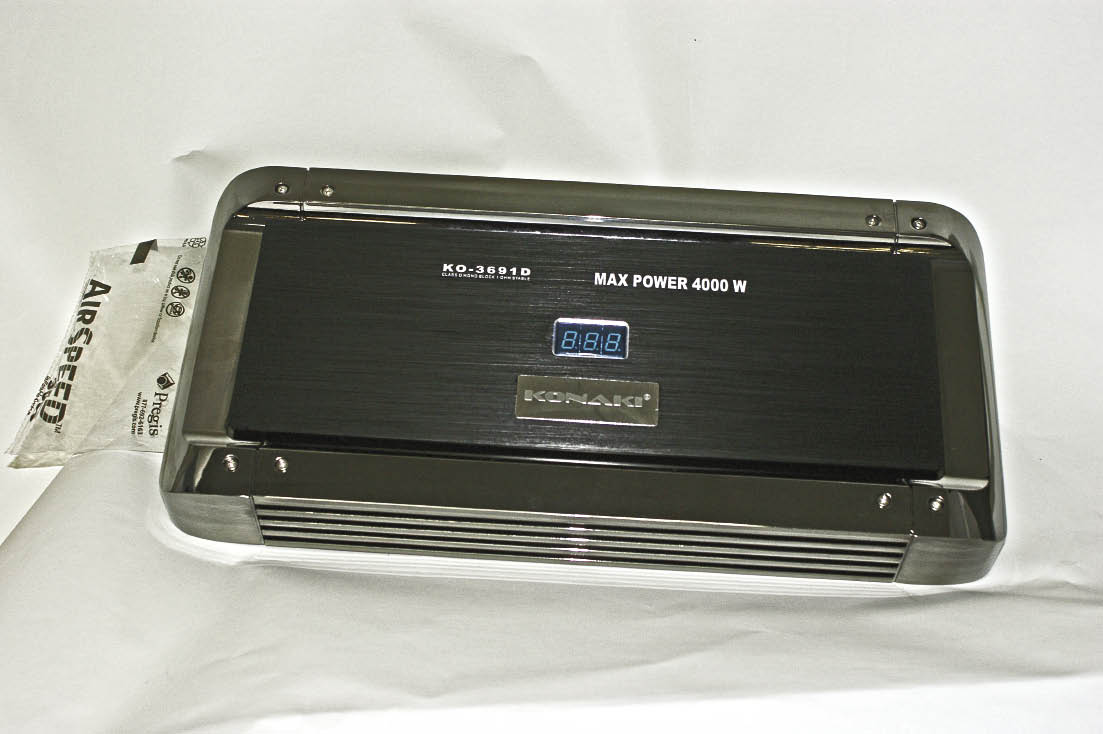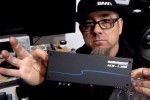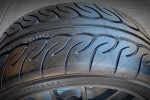Building all kinds of personal electronic products from cameras and MP4 players to a full line of car audio products including head units and video players, Konaki offers a wide range of products to consumers looking for high value, high quality products. And while they’re perhaps not the best known brand out there just yet, if the sample of product they sent me is any indication, they stand a fair to middlin’ chance of becoming one.

A few weeks ago, I received a Konaki KO-3691D Class D subwoofer amplifier ($499.00) to evaluate. Well, the product has been tested, and I came away impressed at the performance for the money.
Features
The KO-3691D is a high power single channel amp, designed to drive subwoofers at any load impedance between 4 and 1 ohms. Power output is rated in the owner’s manual at 500, 900, and 1250 watts into 4, 2, and 1 ohm respectively. As you’d expect with that much power available, the amp isn’t going to fit in your pocket. The KO-3691D is moderately sized, measuring about 20”x 9.5”x 2.5”. Cosmetically the amp is pretty good looking; the sides of the heatsink are chrome plated, as are the removable end caps that hide the wiring connections and controls. Getting really good chrome plating means endless part polishing, which in turn is expensive. For this reason, you don’t see many chrome amps, and if you do, the chrome usually is quite appalling. And while the Konaki’s chrome isn’t going to be confused with a Harley-Davidson part, it’s pretty darn good. The top of the big Konaki amp is a thick piece of aluminum, with a traditional brushed finish, anodized black. In the center of the top plate is a digital voltmeter which provides information on the supply voltage to the amp. The cosmetic treatment results in a combination of understated elegance and enough chrome plating to provide the impressive ‘bling factor.’
I removed the hex head screws that retain the end bells, and had a look at the amps connections and controls. On the connector side of things, all the power and speaker wiring is done on one end of the amp. The power connectors will readily accept 4 gauge power cable, which is what a high power amp needs. Four terminal speaker connections two positive and two negative, were generously sized as well to accept up to 8 gauge wire. The amp comes with four 35A ATC style fuses, which are also mounted on the end panel beside the main power connections. The opposite end of the amplifier is where the RCA input and output connections are made, and where all the adjustable controls live. In terms of control and adjustment features, the Konaki amp delivered a very competent selection, in addition to the usual gain and crossover functions, there is also control for bass EQ, a switchable (in/out) variable subsonic filter, a phase switch, and a wired remote level control. A bright blue LED lights up when the amp is on, and a red one provides an indication of a protection issue. Of course the voltmeter on the top of the amp also illuminates in blue when the amp turns on.
Design
On the inside of the KO-3691D I found more evidence of a quality product, and a pretty good design. In case you have been under the impression that all Class D amps are pretty much the same, let me disabuse you of that particular notion right now. I’ve seen some very good designs and some extremely poor designs when it comes to Class D sub amps. That said, the low priced Konaki is better than average in terms of the parts chosen, and the layout is good too. The power supply uses twelve high current 50N06 MOSFET devices, and the output section is comprised of another twelve high performance International Rectifier MOSFETS. Energy storage for the power supply is handled by eleven 1000?F high temp capacitors. The output section draws current from a bank of four 2200?F caps, which are also of the high temp variety. Crossover filters are -24 dB slopes, instead of the cheaper -12dB type, and poly caps are used where needed. All of the high mass parts are securely fastened and held in place with adhesives. The fact that a car audio amplifier has to endure a harsh environment filled with vibration and temperature extremes was not lost on the Konaki engineers. Even the bars that hold the MOSFETS to the heatsink are equipped with lock washers, and then coated in adhesive to prevent loosening. There is every indication that the amplifier is designed to be very reliable from a mechanical standpoint.
Listening
I moved the Konaki amp into my listening room and connected it to my reference system. For this session, the amplifier was connected to a 2 ohm 12-inch subwoofer in a sealed enclosure. With the crossover set at about 100Hz, and the subsonic filter turned off, I spent a while listening to the amp with a variety of different musical genres. During the listening, I had to continually remind myself of the amps relatively economical price, because it sounded good enough to be compared with amps costing quite a bit more. Of course there was plenty of power, and the KO-3691D drove my reference sub with authority and good control. The remote level control worked well, and I played around a little bit with the other controls. The bass boost worked about as you’d expect, but I got a surprise when I engaged the subsonic filter. With the filters control pot set to 15Hz, I flipped the switch to on, and the output seemed to double! In fact, the difference was drastic enough to startle me. I experimented a bit, but it seems like the subsonic filter switch causes additional gain to be applied. This is not a problem if you know about it when you set the gain, but it can be quite a surprise if you’re not expecting it.
Throughout my listening, the only minor complaint I had other than the subsonic surprise was a small amount of pop noise when the amp turned on and off. Not enough to do any harm, and some people may never even notice it, but it was there.
Read on for the Results
Listening
I moved the Konaki amp into my listening room and connected it to my reference system. For this session, the amplifier was connected to a 2 ohm 12-inch subwoofer in a sealed enclosure. With the crossover set at about 100Hz, and the subsonic filter turned off, I spent a while listening to the amp with a variety of different musical genres. During the listening, I had to continually remind myself of the amps relatively economical price, because it sounded good enough to be compared with amps costing quite a bit more. Of course there was plenty of power, and the KO-3691D drove my reference sub with authority and good control. The remote level control worked well, and I played around a little bit with the other controls. The bass boost worked about as you’d expect, but I got a surprise when I engaged the subsonic filter. With the filters control pot set to 15Hz, I flipped the switch to on, and the output seemed to double! In fact, the difference was drastic enough to startle me. I experimented a bit, but it seems like the subsonic filter switch causes additional gain to be applied. This is not a problem if you know about it when you set the gain, but it can be quite a surprise if you’re not expecting it.
Throughout my listening, the only minor complaint I had other than the subsonic surprise was a small amount of pop noise when the amp turned on and off. Not enough to do any harm, and some people may never even notice it, but it was there.
Read on for the Results
Related Articles
 Steve Meade Unboxes, Plays and Dyno Tests the AudioControl ACM Micro Amplifiers
Steve Meade Unboxes, Plays and Dyno Tests the AudioControl ACM Micro Amplifiers
Steve Meade of West Coast Car Audio is seen in this video unboxing, playing and dyno testing the micro AudioControl ACM 1.300 mirco amplifier...
 Yokohama Advan Neova AD08R Tire Review
Yokohama Advan Neova AD08R Tire Review
I attended an SCCA Track Night In America event at Portland International Raceway and had a chance to test out a set of Yokohama Advan Neova...
 Kenwood XR600-6DSP Amplifier Review
Kenwood XR600-6DSP Amplifier Review
Anyone who has ever attempted to upgrade a factory audio system with some real power knows the challenges involved.
Depending on the specific car,...
 Pioneer AVIC-8400 NEX DVD/NAV Receiver Review
Pioneer AVIC-8400 NEX DVD/NAV Receiver Review
Ah, technology.
While it’s a struggle to simply keep abreast of all the latest and greatest advancements, there’s no argument that technology is a...
 Pioneer TS-D12D2 12” Subwoofer Review
Pioneer TS-D12D2 12” Subwoofer Review
If you’re serious about pounding out bass, then you already know you want a no-compromise, truly high-performance subwoofer that can handle the...
 Clarion CMS4 Multi-Zone Marine Receiver Review
Clarion CMS4 Multi-Zone Marine Receiver Review
For our readers who enjoy spending some quality time on the water or find solace trekking through sand dunes in their powersports vehicles, we’re...




